Hyundai Santa Fe 2005 Owner's Manual
Manufacturer: HYUNDAI, Model Year: 2005, Model line: Santa Fe, Model: Hyundai Santa Fe 2005Pages: 277, PDF Size: 10.53 MB
Page 241 of 277
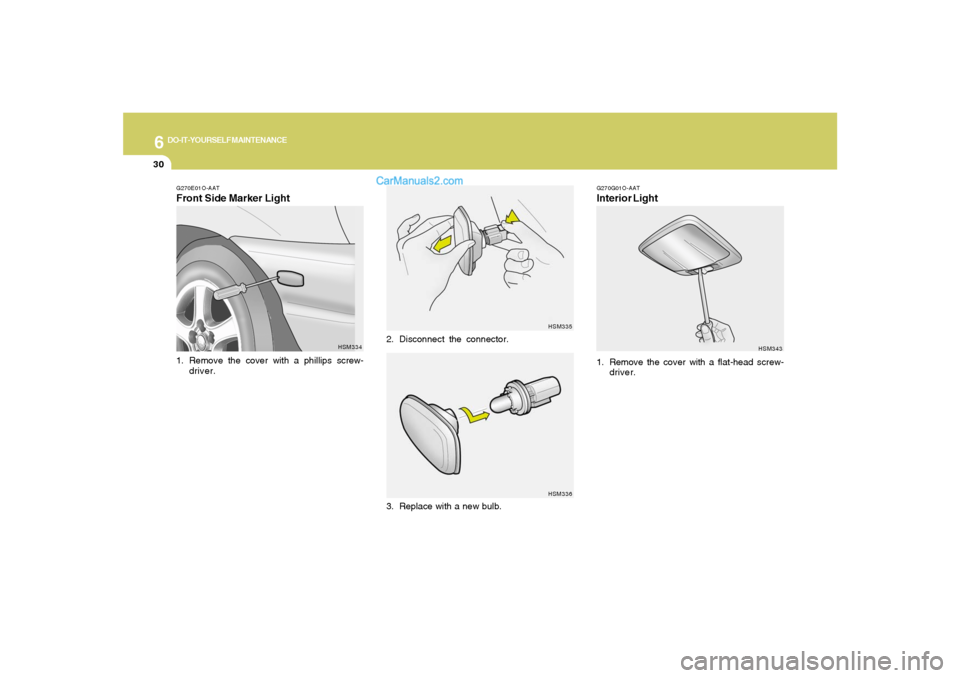
6
DO-IT-YOURSELF MAINTENANCE
30
G270E01O-AATFront Side Marker Light1. Remove the cover with a phillips screw-
driver.
HSM334HSM335
HSM336
2. Disconnect the connector.
3. Replace with a new bulb.
G270G01O-AATInterior Light
HSM343
1. Remove the cover with a flat-head screw-
driver.
Page 242 of 277
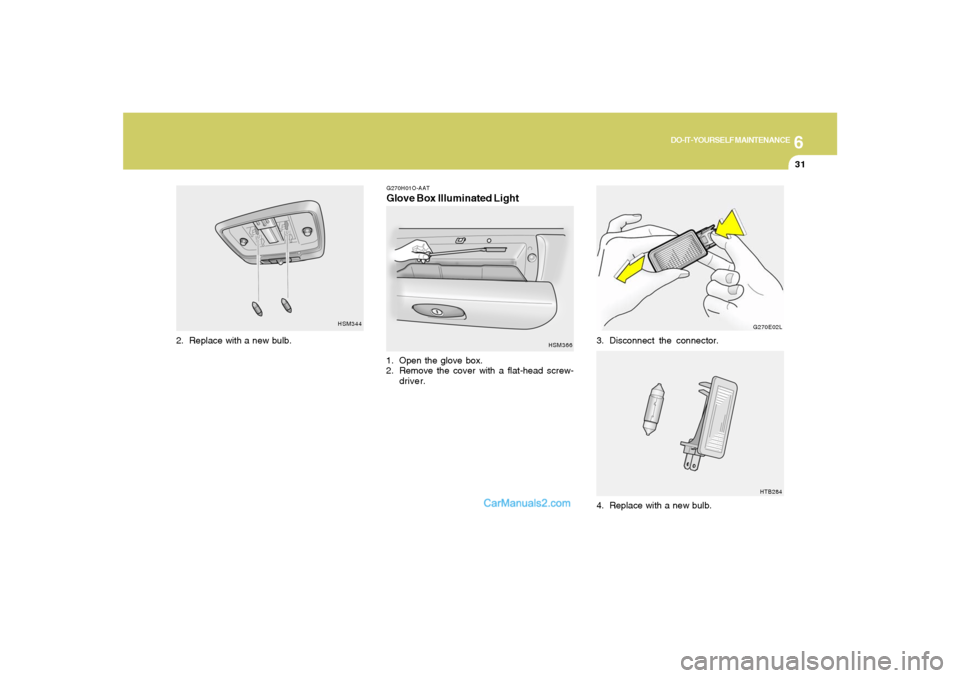
6
DO-IT-YOURSELF MAINTENANCE
31
G270E02L
HTB284
3. Disconnect the connector.
4. Replace with a new bulb.
HSM344
2. Replace with a new bulb.
G270H01O-AATGlove Box Illuminated Light1. Open the glove box.
2. Remove the cover with a flat-head screw-
driver.
HSM366
Page 243 of 277
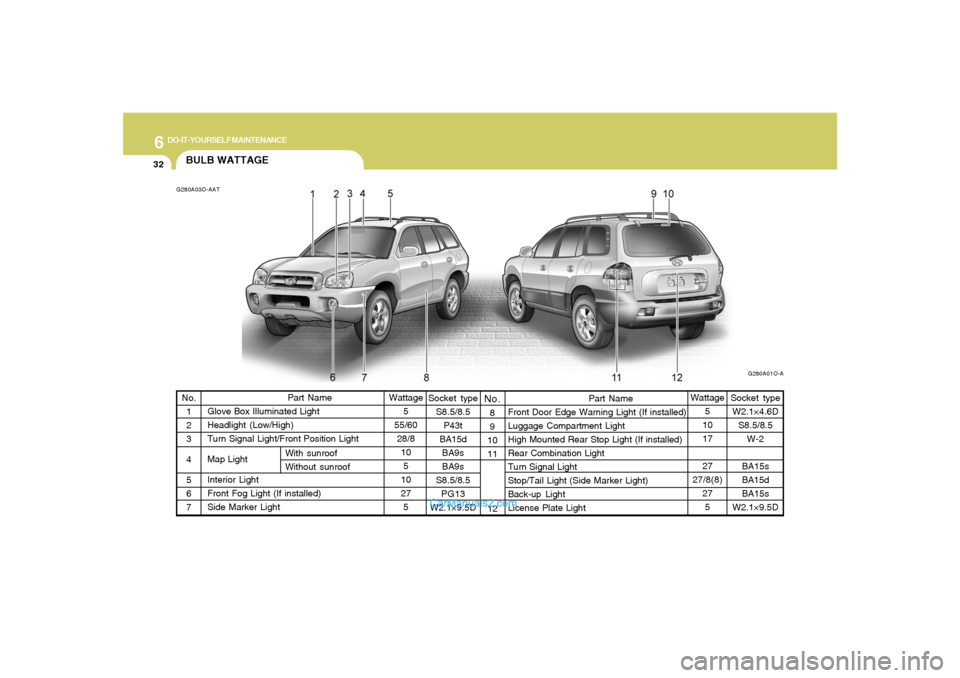
6
DO-IT-YOURSELF MAINTENANCE
32
Socket type
S8.5/8.5
P43t
BA15d
BA9s
BA9s
S8.5/8.5
PG13
W2.1×9.5D
Part Name
Front Door Edge Warning Light (If installed)
Luggage Compartment Light
High Mounted Rear Stop Light (If installed)
Rear Combination Light
Turn Signal Light
Stop/Tail Light (Side Marker Light)
Back-up Light
License Plate LightWattage
5
10
17
27
27/8(8)
27
5 No.
1
2
3
4
5
6
7
BULB WATTAGEG280A03O-AAT
G280A01O-A
Part Name
Glove Box Illuminated Light
Headlight (Low/High)
Turn Signal Light/Front Position Light
Map Light
Interior Light
Front Fog Light (If installed)
Side Marker LightWattage
5
55/60
28/8
10
5
10
27
5
No.
With sunroof
Without sunroof8
9
10
11
12
Socket type
W2.1×4.6D
S8.5/8.5
W-2
BA15s
BA15d
BA15s
W2.1×9.5D
Page 244 of 277
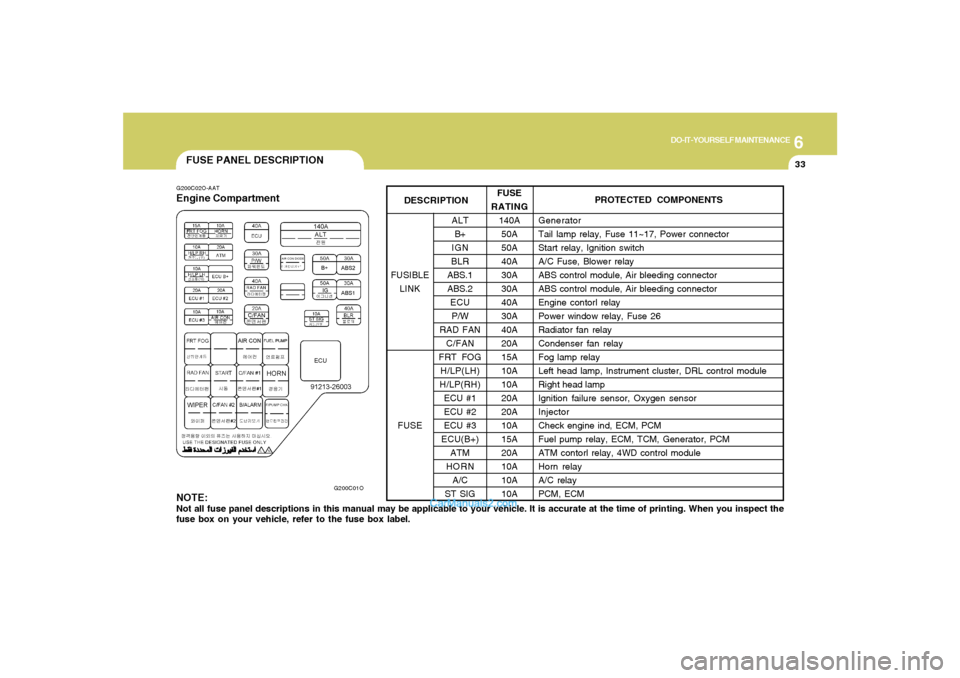
6
DO-IT-YOURSELF MAINTENANCE
33
FUSE PANEL DESCRIPTIONG200C02O-AATEngine Compartment
G200C01O
NOTE:Not all fuse panel descriptions in this manual may be applicable to your vehicle. It is accurate at the time of printing. When you inspect the
fuse box on your vehicle, refer to the fuse box label.FUSE
RATING
140A
50A
50A
40A
30A
30A
40A
30A
40A
20A
15A
10A
10A
20A
20A
10A
15A
20A
10A
10A
10APROTECTED COMPONENTS
Generator
Tail lamp relay, Fuse 11~17, Power connector
Start relay, Ignition switch
A/C Fuse, Blower relay
ABS control module, Air bleeding connector
ABS control module, Air bleeding connector
Engine contorl relay
Power window relay, Fuse 26
Radiator fan relay
Condenser fan relay
Fog lamp relay
Left head lamp, Instrument cluster, DRL control module
Right head lamp
Ignition failure sensor, Oxygen sensor
Injector
Check engine ind, ECM, PCM
Fuel pump relay, ECM, TCM, Generator, PCM
ATM contorl relay, 4WD control module
Horn relay
A/C relay
PCM, ECM
ALT
B+
IGN
BLR
ABS.1
ABS.2
ECU
P/W
RAD FAN
C/FAN
FRT FOG
H/LP(LH)
H/LP(RH)
ECU #1
ECU #2
ECU #3
ECU(B+)
ATM
HORN
A/C
ST SIG FUSIBLE
LINK
FUSE
DESCRIPTION
Page 245 of 277
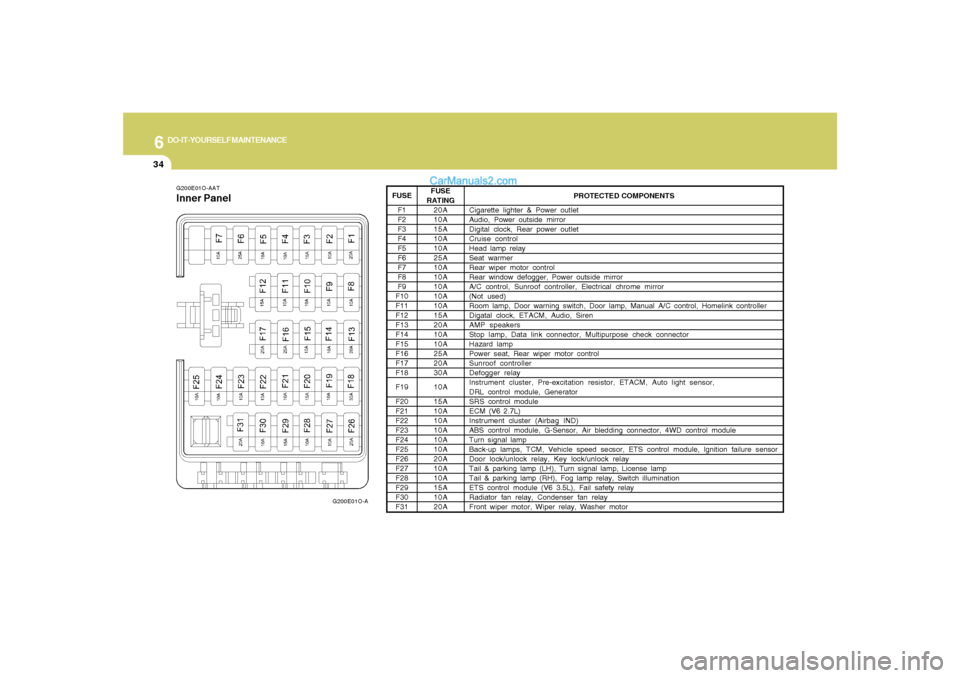
6
DO-IT-YOURSELF MAINTENANCE
34
G200E01O-AATInner Panel
G200E01O-A
PROTECTED COMPONENTS
Cigarette lighter & Power outlet
Audio, Power outside mirror
Digital clock, Rear power outlet
Cruise control
Head lamp relay
Seat warmer
Rear wiper motor control
Rear window defogger, Power outside mirror
A/C control, Sunroof controller, Electrical chrome mirror
(Not used)
Room lamp, Door warning switch, Door lamp, Manual A/C control, Homelink controller
Digatal clock, ETACM, Audio, Siren
AMP speakers
Stop lamp, Data link connector, Multipurpose check connector
Hazard lamp
Power seat, Rear wiper motor control
Sunroof controller
Defogger relay
Instrument cluster, Pre-excitation resistor, ETACM, Auto light sensor,
DRL control module, Generator
SRS control module
ECM (V6 2.7L)
Instrument cluster (Airbag IND)
ABS control module, G-Sensor, Air bledding connector, 4WD control module
Turn signal lamp
Back-up lamps, TCM, Vehicle speed secsor, ETS control module, Ignition failure sensor
Door lock/unlock relay, Key lock/unlock relay
Tail & parking lamp (LH), Turn signal lamp, License lamp
Tail & parking lamp (RH), Fog lamp relay, Switch illumination
ETS control module (V6 3.5L), Fail safety relay
Radiator fan relay, Condenser fan relay
Front wiper motor, Wiper relay, Washer motor
FUSE
RATING
20A
10A
15A
10A
10A
25A
10A
10A
10A
10A
10A
15A
20A
10A
10A
25A
20A
30A
10A
15A
10A
10A
10A
10A
10A
20A
10A
10A
15A
10A
20A FUSE
F1
F2
F3
F4
F5
F6
F7
F8
F9
F10
F11
F12
F13
F14
F15
F16
F17
F18
F19
F20
F21
F22
F23
F24
F25
F26
F27
F28
F29
F30
F31
Page 246 of 277
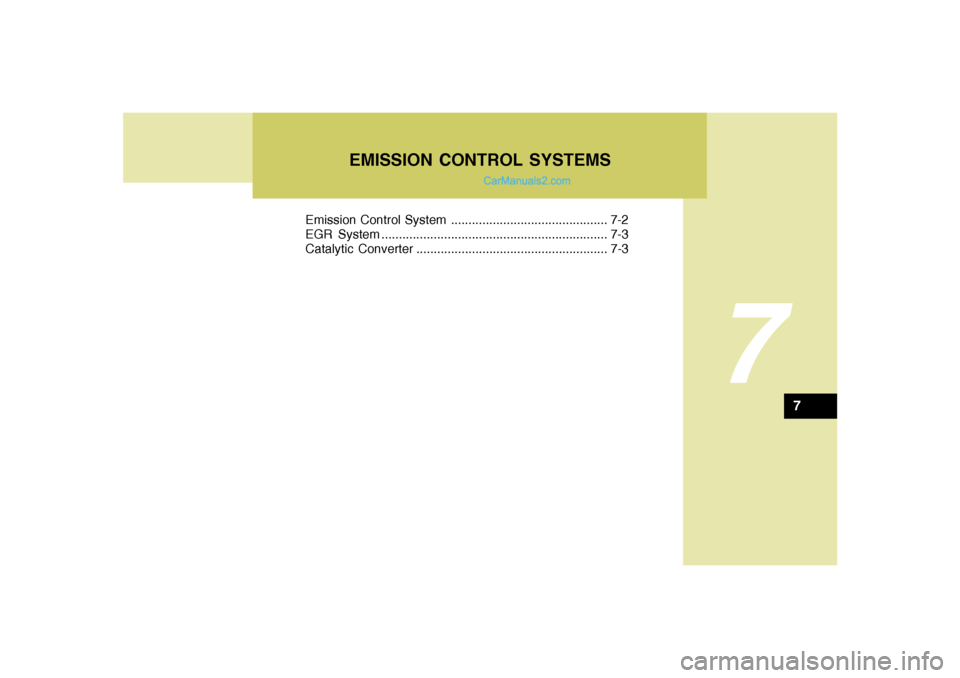
7
Emission Control System ............................................. 7-2
EGR System ................................................................. 7-3
Catalytic Converter ....................................................... 7-3
EMISSION CONTROL SYSTEMS
7
Page 247 of 277
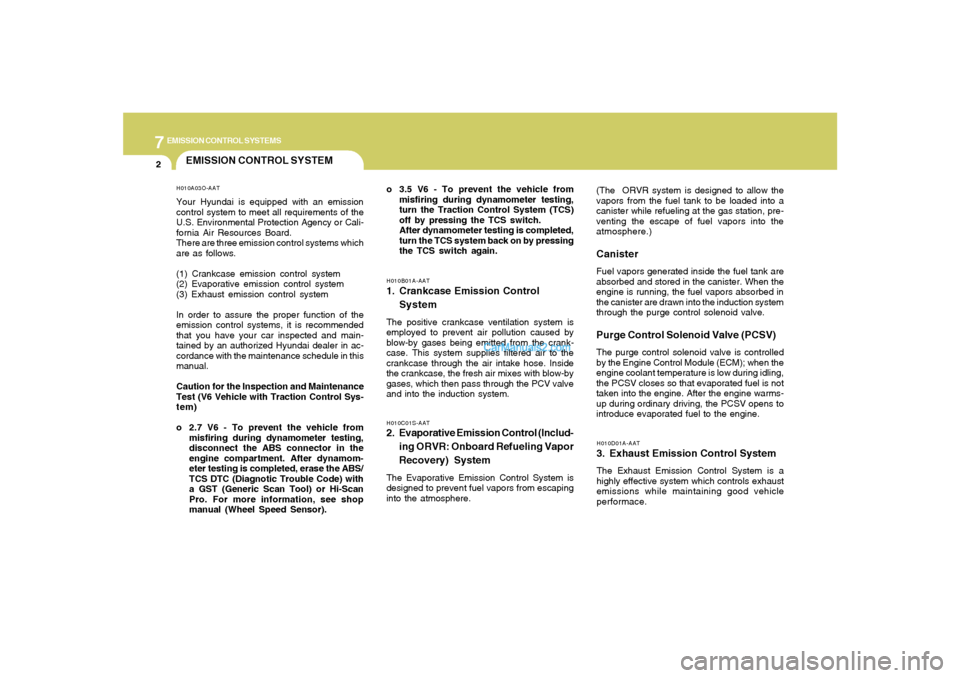
7
EMISSION CONTROL SYSTEMS2
EMISSION CONTROL SYSTEM
H010D01A-AAT3. Exhaust Emission Control SystemThe Exhaust Emission Control System is a
highly effective system which controls exhaust
emissions while maintaining good vehicle
performace.
H010B01A-AAT1. Crankcase Emission Control
SystemThe positive crankcase ventilation system is
employed to prevent air pollution caused by
blow-by gases being emitted from the crank-
case. This system supplies filtered air to the
crankcase through the air intake hose. Inside
the crankcase, the fresh air mixes with blow-by
gases, which then pass through the PCV valve
and into the induction system.
H010A03O-AATYour Hyundai is equipped with an emission
control system to meet all requirements of the
U.S. Environmental Protection Agency or Cali-
fornia Air Resources Board.
There are three emission control systems which
are as follows.
(1) Crankcase emission control system
(2) Evaporative emission control system
(3) Exhaust emission control system
In order to assure the proper function of the
emission control systems, it is recommended
that you have your car inspected and main-
tained by an authorized Hyundai dealer in ac-
cordance with the maintenance schedule in this
manual.
Caution for the Inspection and Maintenance
Test (V6 Vehicle with Traction Control Sys-
tem)
o 2.7 V6 - To prevent the vehicle from
misfiring during dynamometer testing,
disconnect the ABS connector in the
engine compartment. After dynamom-
eter testing is completed, erase the ABS/
TCS DTC (Diagnotic Trouble Code) with
a GST (Generic Scan Tool) or Hi-Scan
Pro. For more information, see shop
manual (Wheel Speed Sensor).(The ORVR system is designed to allow the
vapors from the fuel tank to be loaded into a
canister while refueling at the gas station, pre-
venting the escape of fuel vapors into the
atmosphere.)
CanisterFuel vapors generated inside the fuel tank are
absorbed and stored in the canister. When the
engine is running, the fuel vapors absorbed in
the canister are drawn into the induction system
through the purge control solenoid valve.Purge Control Solenoid Valve (PCSV)The purge control solenoid valve is controlled
by the Engine Control Module (ECM); when the
engine coolant temperature is low during idling,
the PCSV closes so that evaporated fuel is not
taken into the engine. After the engine warms-
up during ordinary driving, the PCSV opens to
introduce evaporated fuel to the engine.
H010C01S-AAT2. Evaporative Emission Control (Includ-
ing ORVR: Onboard Refueling Vapor
Recovery) SystemThe Evaporative Emission Control System is
designed to prevent fuel vapors from escaping
into the atmosphere. o 3.5 V6 - To prevent the vehicle from
misfiring during dynamometer testing,
turn the Traction Control System (TCS)
off by pressing the TCS switch.
After dynamometer testing is completed,
turn the TCS system back on by pressing
the TCS switch again.
Page 248 of 277
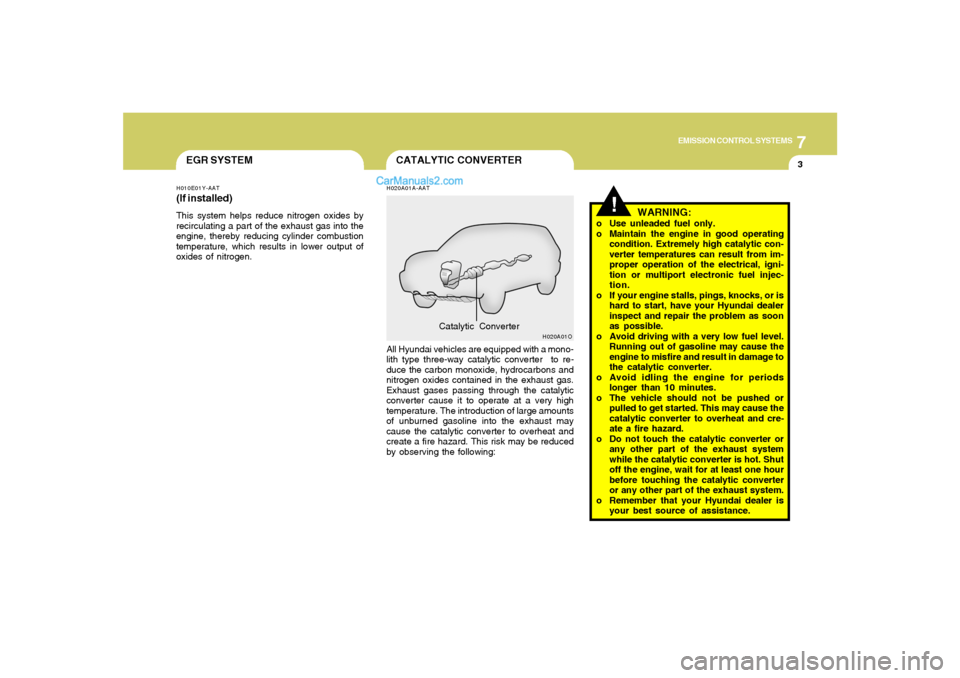
7
EMISSION CONTROL SYSTEMS
3
CATALYTIC CONVERTER
EGR SYSTEM
!
H010E01Y-AAT(If installed)This system helps reduce nitrogen oxides by
recirculating a part of the exhaust gas into the
engine, thereby reducing cylinder combustion
temperature, which results in lower output of
oxides of nitrogen.
WARNING:
o Use unleaded fuel only.
o Maintain the engine in good operating
condition. Extremely high catalytic con-
verter temperatures can result from im-
proper operation of the electrical, igni-
tion or multiport electronic fuel injec-
tion.
o If your engine stalls, pings, knocks, or is
hard to start, have your Hyundai dealer
inspect and repair the problem as soon
as possible.
o Avoid driving with a very low fuel level.
Running out of gasoline may cause the
engine to misfire and result in damage to
the catalytic converter.
o Avoid idling the engine for periods
longer than 10 minutes.
o The vehicle should not be pushed or
pulled to get started. This may cause the
catalytic converter to overheat and cre-
ate a fire hazard.
o Do not touch the catalytic converter or
any other part of the exhaust system
while the catalytic converter is hot. Shut
off the engine, wait for at least one hour
before touching the catalytic converter
or any other part of the exhaust system.
o Remember that your Hyundai dealer is
your best source of assistance.
H020A01A-AATAll Hyundai vehicles are equipped with a mono-
lith type three-way catalytic converter to re-
duce the carbon monoxide, hydrocarbons and
nitrogen oxides contained in the exhaust gas.
Exhaust gases passing through the catalytic
converter cause it to operate at a very high
temperature. The introduction of large amounts
of unburned gasoline into the exhaust may
cause the catalytic converter to overheat and
create a fire hazard. This risk may be reduced
by observing the following:
H020A01O
Catalytic Converter
Page 249 of 277
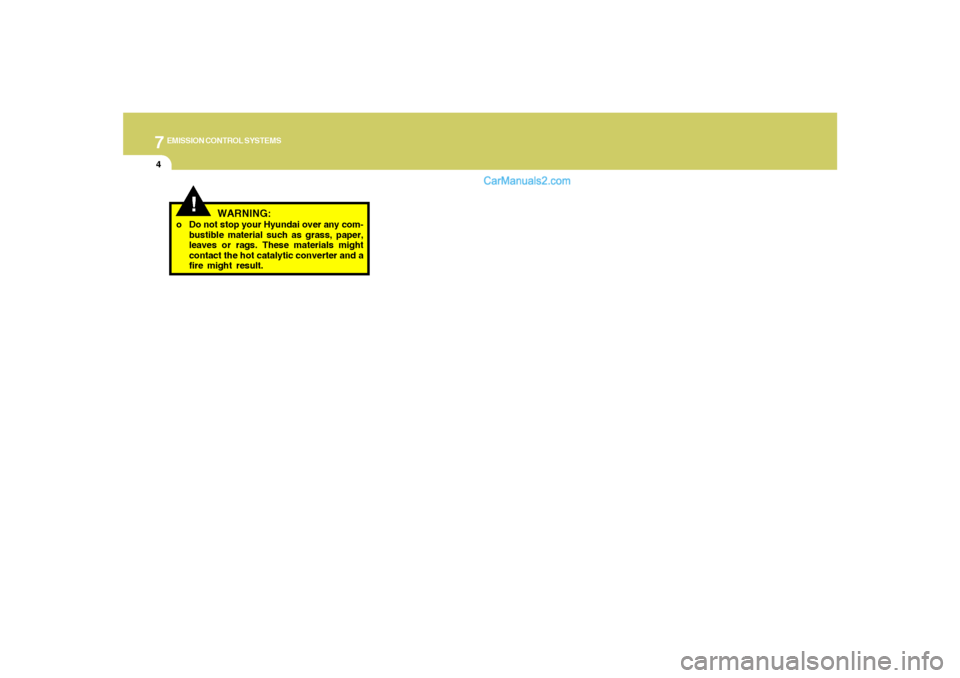
7
EMISSION CONTROL SYSTEMS4
!
WARNING:
o Do not stop your Hyundai over any com-
bustible material such as grass, paper,
leaves or rags. These materials might
contact the hot catalytic converter and a
fire might result.
Page 250 of 277
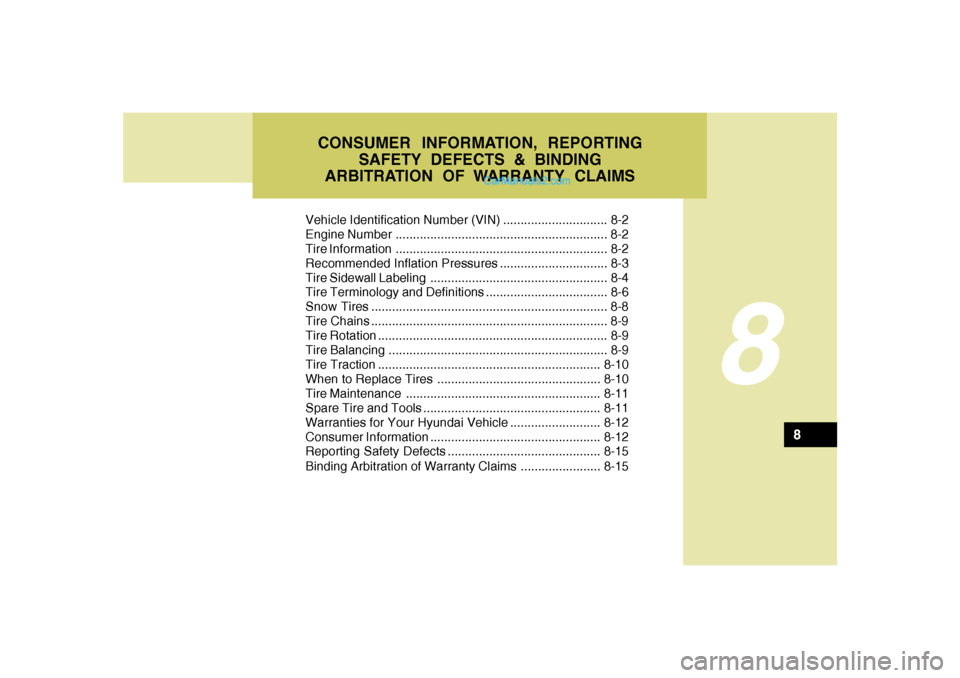
Vehicle Identification Number (VIN) .............................. 8-2
Engine Number ............................................................. 8-2
Tire Information ............................................................. 8-2
Recommended Inflation Pressures ............................... 8-3
Tire Sidewall Labeling ................................................... 8-4
Tire Terminology and Definitions ................................... 8-6
Snow Tires .................................................................... 8-8
Tire Chains .................................................................... 8-9
Tire Rotation .................................................................. 8-9
Tire Balancing ............................................................... 8-9
Tire Traction................................................................8-10
When to Replace Tires ...............................................8-10
Tire Maintenance........................................................8-11
Spare Tire and Tools ...................................................8-11
Warranties for Your Hyundai Vehicle..........................8-12
Consumer Information.................................................8-12
Reporting Safety Defects............................................8-15
Binding Arbitration of Warranty Claims.......................8-15
CONSUMER INFORMATION, REPORTING
SAFETY DEFECTS & BINDING
ARBITRATION OF WARRANTY CLAIMS
8
8